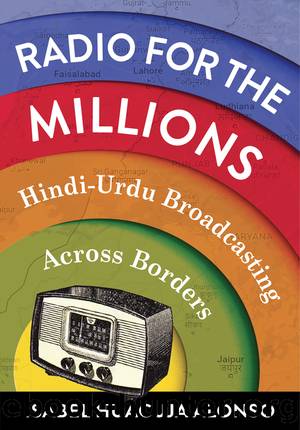Radio for the Millions by Isabel Huacuja Alonso

Author:Isabel Huacuja Alonso
Language: eng
Format: epub
Tags: PER008010, Performing Arts/Radio/History & Criticism, SOC052000, Social Science/Media Studies
Publisher: Columbia University Press
Published: 2023-01-03T00:00:00+00:00
Language as Transmission
As we might expect, NidÄ conflates language with religion in the most overt possible manner. In the absence of visual clues, the charactersâ diction becomes the most important signifier of communal identity. We know that Mahashay is Hindu because he speaks âHindiâ and uses Sanskrit-derived words, and we know that Mian is Muslim because he speaks polished âUrduâ and not only employs Arabic- and Persian-origin words, but also pronounces them correctly. As Urdu speakers put it, Mianâs âsheensâ and âqafsâ were impeccable.
Still, it is notable that at no point do the characters have trouble communicating. Mahashay sprinkles in a few difficult Sanskrit words here and there, but that does not stop Mian from perfectly understanding what Mahashay has to say. Nor does it stop Mahashay from conveying the programâs message to the Urdu- and Punjabi-speaking audience in Lahore and Karachi. Indeed, the playâs writer, Naseer Anwar, received a great deal of praise for his command of Hindi. For instance, Rais Ahmad, a Pakistani listener and fan of this program, explained: âThe strangeness of the language did not make it difficult to listen to it and enjoy it. On the contrary, it made it more enjoyable.â83 Another listener remarked: âFrom the program you could tell that the writer was very aware of Hindu traditions. The language was beautiful, and I wanted it to last longer.â84 Intizar Hussain, a celebrated Urdu writer, explained in an article: âThe Hindi that Nazir Anwar would writeânow nobody else can do.â85 Most interesting, in NidÄ, the demarcation of linguistic and national difference between Urdu and Hindi hinges upon the audienceâs familiarity with Hindi. It is noteworthy that the strongest expressions of Urdu-Hindi hostility, and in this case, Indian-Pakistani hostility in the 1965 war, depend on the intimate familiarity of Hindi. In NidÄ, the listenersâ audioposition, between the two main characters, Mian and Mahashay, creates a feeling that we are listening in or prying into a private conversation. That prying, however, depends on intelligibility between the two characters and between the audience and the characters.
Naseer Anwar also uses language to demonstrate Mianâs cultural and linguistic superiority. Ultimately, NidÄ is a linguistic feud between Mahashay (India) and Mian (Pakistan), and in every episode, Mian wins the battle of the tongue. Mahashay mispronounces the first name of Indiaâs own vice president calling him âJakir instead of Zakir.â Mahashay cannot even say the name of the region that he claims rightfully belongs to India. Again and again, Mahashay says âKasmirâ instead of âKashmir.â It is clear that these are not just mispronunciations but rather are markers of Urdu-speakersâ linguistic superiority.
What goes unspoken, but is impossible to miss, is that NidÄ is deeply invested in presenting Urdu as the sole and rightful national language of Pakistan, countering East Pakistanâs claims that Bengali should be a joint national language. Herein lies what was perhaps NidÄâs most important message. In the play, Mian repeatedly tells radio listeners: âThis is the voice of Pakistan.â Mianâs statement echoes the first governor-general of Pakistan,
Download
This site does not store any files on its server. We only index and link to content provided by other sites. Please contact the content providers to delete copyright contents if any and email us, we'll remove relevant links or contents immediately.
| General Broadcasting | History & Criticism |
| Reference |
Childhood's End by Arthur C. Clarke(1784)
The Fellowship of the Ring (The Lord of the Ring, #1) by J.R.R. Tolkien(1575)
Childhood's end by Arthur C. Clarke(1398)
Tolkien, J. R. R. - The Fellowship of the Ring by Tolkien J. R. R(1190)
The Stars Are Fire by Anita Shreve(1172)
Ballet For Dummies by Scott Speck & Evelyn Cisneros(1165)
Howard Stern Comes Again (9781501194313) by Stern Howard(1108)
Black Privilege by Charlamagne Tha God(1088)
The Lord of the Rings: The Fellowship of the Ring, the Two Towers, the Return of the King by J. R. R. Tolkien(1084)
The Return of the King by J.R.R. Tolkien(1055)
Dark Fire by C.J. Sansom(1009)
The Lord Of The Rings Part 03: The Return Of The King by J.R.R. Tolkien(1000)
Agatha Christie - 1945 - Sparkling Cyanide by Agatha Christie(991)
Frenchman's Creek by Daphne Du Maurier(953)
Narnia 02 - The Lion, the Witch and the Wardrobe by C. S. Lewis(927)
Lord of the Rings 0.5 - The Silmarillion by J. R. R. Tolkien(906)
The Fellowship Of The Ring by J.R.R. Tolkien(900)
The Collected Raymond Chandler by Raymond Chandler(890)
The Hitchhiker's Guide to the Galaxy Original Radio Scripts by Douglas Adams(884)
